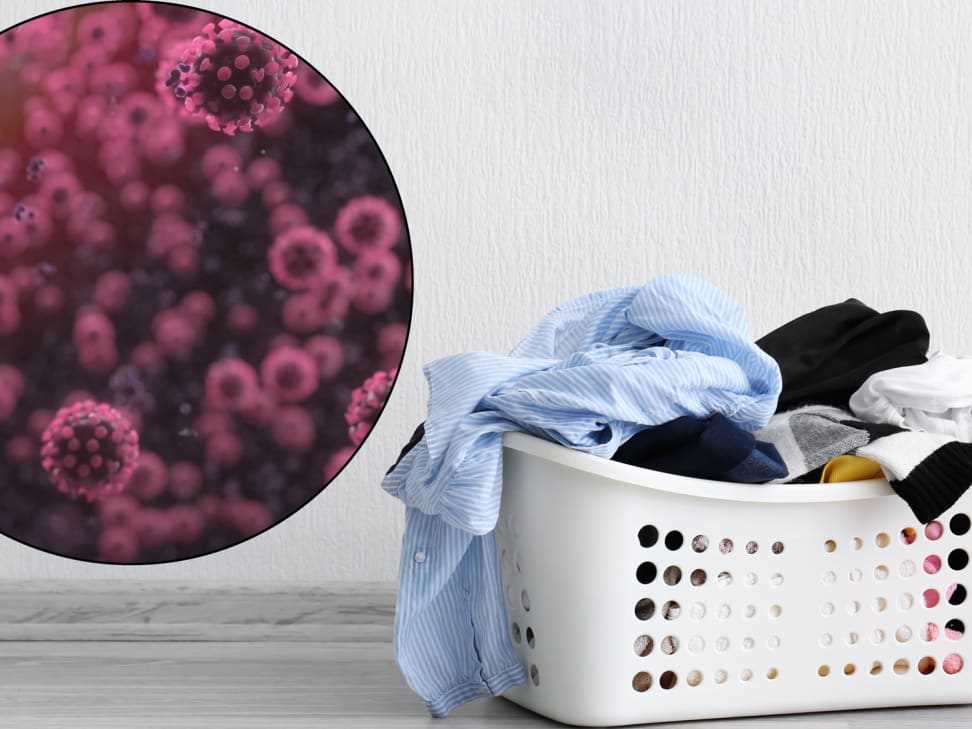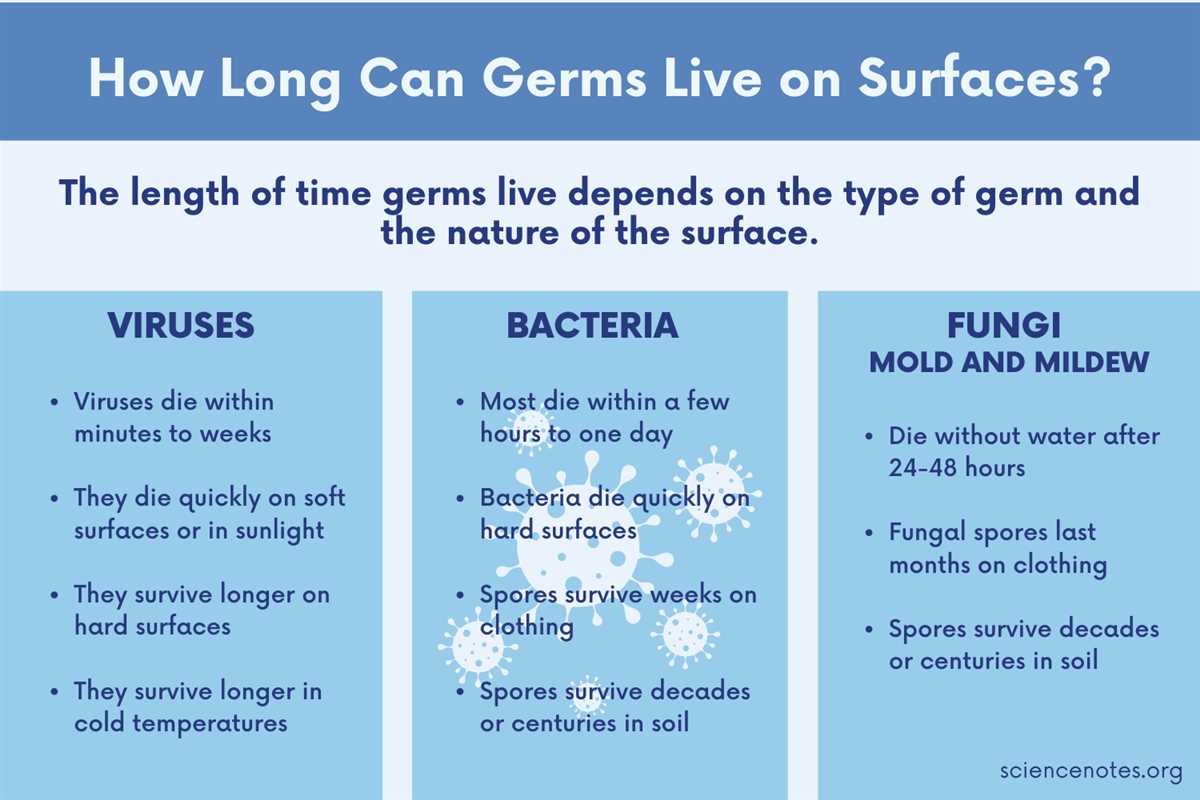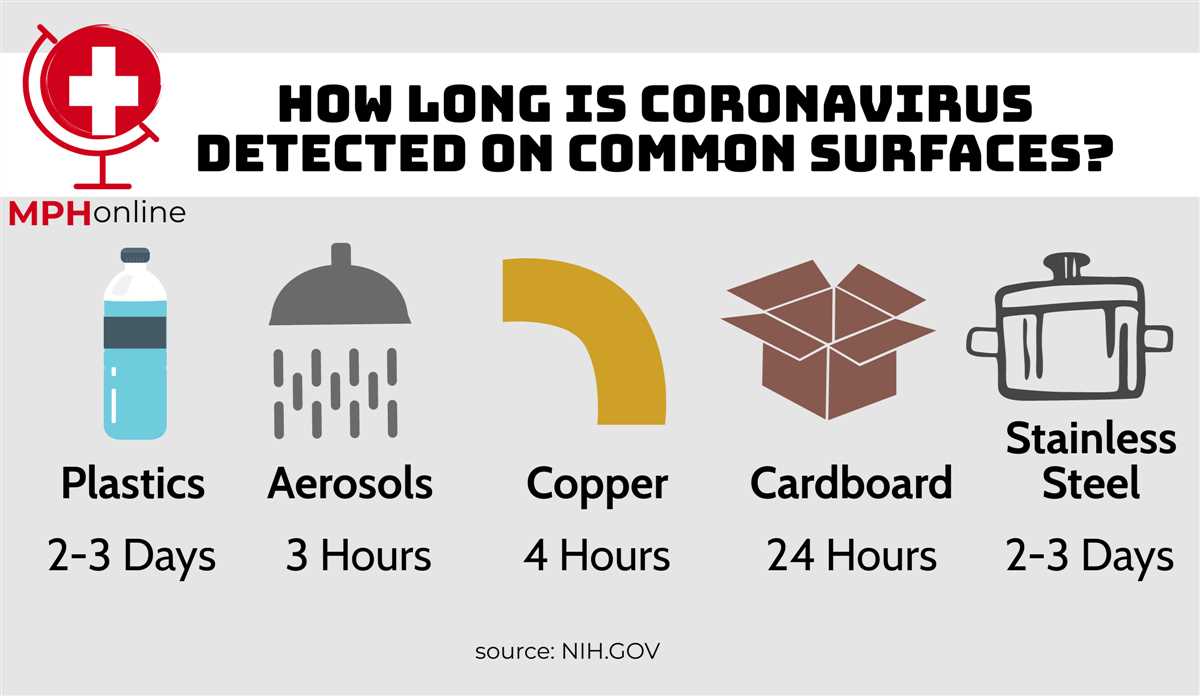




Have you ever wondered how long germs can survive on your clothes? With the ongoing concern about germs and bacteria, especially in the midst of a global pandemic, it’s important to understand the lifespan of these microorganisms on different surfaces, including clothing.
Germs, such as bacteria and viruses, can readily find their way onto our clothes through various means, including direct contact or exposure to contaminated surfaces. The length of time that these germs can survive on clothing depends on several factors, including the type of germ, environmental conditions, and the material of the clothing itself.
Studies have shown that certain germs can remain viable on clothing for varying lengths of time. For example, some bacteria, like Staphylococcus aureus, can survive on fabric for up to 24 hours. On the other hand, the flu virus can live on clothing for as long as 8-12 hours. These numbers may vary depending on the specific conditions in which the germs are exposed, such as humidity and temperature.
It’s also worth noting that the material of your clothing can influence the survival of germs. Porous materials, like cotton, may absorb moisture and nutrients, providing an environment that can support the growth and survival of bacteria. Synthetic materials, on the other hand, may not provide the same level of moisture and nutrients, potentially reducing the lifespan of germs on the fabric.
In conclusion, germs can survive on clothes for varying lengths of time, depending on factors such as the type of germ, environmental conditions, and the material of the clothing. It’s important to practice good hygiene by regularly washing your clothes, especially in situations where exposure to germs is likely. By doing so, you can reduce the risk of spreading pathogens and help keep yourself and others safe.
Must-HaveWYKDL UV Allergen Vacuum for BeddingHigh-efficiency UV disinfection technologyRemove dust mites and allergens effectively from bedding and upholstery. Achieve a cleaner, healthier sleep environment with UV-C light and strong suction power.
How Long Can Germs Survive on Clothes?

Germs can survive on clothes for varying amounts of time depending on the type of germ, the fabric of the clothing, and the environmental conditions. Understanding how long germs can survive on clothes can help inform proper cleaning and hygiene practices.
Factors Affecting Germ Survival on Clothes
Several factors can influence how long germs can survive on clothes:
- Type of Germ: Different types of germs have varying lifespans. Some common types of germs that can be found on clothes include bacteria, viruses, and fungi.
- Fabric Material: The type of fabric can also affect germ survival. Porous materials, such as cotton, can hold onto moisture and provide a suitable environment for germs to thrive.
- Environmental Conditions: The temperature, humidity, and exposure to sunlight can all impact how long germs can survive on clothes. Certain germs may be more resistant to adverse conditions, while others may thrive in specific environments.
Common Germs Found on Clothes
Various germs can be present on clothes. Some examples include:
- Bacteria: Bacteria can survive on clothes for hours to days, depending on the type. Some common bacteria found on clothes include Staphylococcus aureus and Escherichia coli (E. coli).
- Viruses: Viruses can survive on clothes for several hours to a few days. Examples of viruses that can be found on clothes include the influenza virus and norovirus.
- Fungi: Fungi, such as mold and yeast, can thrive on clothes that are damp or stored in humid environments. They can survive for an extended period if the conditions are favorable.
Preventing Germ Transmission through Clothes
To prevent the spread of germs through clothes, it is important to adhere to good hygiene practices:
- Regularly wash clothes with hot water and detergent. This helps to eliminate germs and prevent their spread.
- Avoid wearing clothes that contain bodily fluids, such as sweat or saliva, for an extended period.
- Do not share clothes or personal items with others, especially if they are known to be sick or carrying contagious germs.
- Use appropriate disinfectants or laundry additives to sanitize clothes, especially during outbreaks or when dealing with highly contagious germs.
| Germ Type | Typical Survival Time on Clothes |
|---|---|
| Bacteria | Hours to days |
| Viruses | Several hours to a few days |
| Fungi | Depends on the environmental conditions |
Factors Affecting the Survival of Germs on Clothes

There are several factors that can affect the survival of germs on clothes. Understanding these factors can help you take appropriate measures to effectively remove or destroy harmful bacteria and viruses from your garments.
Fabric Type
The type of fabric plays a significant role in determining how long germs can survive on clothes. Porous fabrics such as cotton, bamboo, and linen tend to provide a better environment for germs to thrive compared to synthetic fabrics like polyester and nylon. This is because porous fabrics can absorb moisture, providing a moist environment for bacteria to grow and survive.
Humidity
The level of humidity in the environment also affects the survival of germs on clothes. High humidity levels create a moist environment that promotes the growth and survival of bacteria and viruses. On the other hand, low humidity levels can make it difficult for germs to survive, as they require a certain amount of moisture to thrive. It is important to keep in mind that humidity levels indoors can be influenced by factors such as air conditioning, heating systems, and ventilation.
Temperature

The temperature at which clothes are stored or exposed to can impact the survival of germs. Higher temperatures tend to accelerate the growth and proliferation of bacteria and viruses, while lower temperatures can slow down their growth or even cause them to become dormant. Washing clothes at higher temperatures, such as using hot water, can help eliminate germs more effectively.
Cleaning Products and Methods
The types of cleaning products and methods used to launder clothes also play a crucial role in removing or destroying germs. Certain detergents and disinfectants are specifically designed to kill germs and remove stains from clothes. Using these products, along with proper washing techniques such as soaking, agitation, and rinsing, can help eliminate a significant amount of germs present on clothes.
Duration of Contamination
The length of time that clothes remain contaminated with germs can also affect their survival. The longer germs are present on clothes, the more likely they are to multiply and persist. It is important to promptly treat and clean clothes that come into contact with potentially harmful substances, such as bodily fluids or contaminated surfaces, to minimize the risk of germ survival.
Personal Hygiene and Habits
Personal hygiene practices and habits can also influence the survival of germs on clothes. For example, if you have clean hands and avoid touching your face or handling dirty objects while wearing clothes, you can reduce the chances of transferring germs onto your garments. Regular handwashing and avoiding close contact with individuals who are sick can help prevent the spread of germs.
Conclusion

Understanding the factors that affect the survival of germs on clothes can empower you to take proactive measures in maintaining proper hygiene and reducing the risk of infections. By choosing the right fabrics, controlling humidity and temperature, using appropriate cleaning products, and practicing good personal hygiene, you can ensure that your clothes remain a safe and germ-free environment.
Common Types of Germs Found on Clothes
Clothes can harbour a variety of germs and bacteria, some of which can be harmful to our health. Understanding the types of germs commonly found on clothes can help us take appropriate measures to keep ourselves and our loved ones safe.
1. Staphylococcus aureus
Staphylococcus aureus, or staph, is a type of bacteria commonly found on our skin and in our noses. It can cause infections, including skin infections, pneumonia, and bloodstream infections. Staph bacteria can be easily transferred to clothes through direct contact with skin.
2. Escherichia coli (E. coli)
E. coli is a type of bacteria that normally lives in our intestines. However, certain strains of E. coli can cause severe gastrointestinal illnesses. These bacteria can be present on clothing that has been contaminated with fecal matter or through improper hygiene practices.
3. Influenza Virus
The influenza virus, commonly known as the flu, can survive on surfaces for a short time, including on clothes. If an infected person coughs or sneezes near clothes, the virus can land on the fabric and potentially infect others. It is important to practice good respiratory hygiene, such as covering your mouth and nose when coughing or sneezing.
4. Norovirus

Norovirus is a highly contagious virus that can cause gastroenteritis, leading to symptoms like vomiting and diarrhea. It can survive on clothing for several days and can be transmitted through direct contact with contaminated clothes or surfaces. Proper hand hygiene, including washing hands thoroughly, is crucial to prevent the spread of norovirus.
5. Candida albicans

Candida albicans is a type of fungus that is naturally present in our bodies, particularly in the mouth, intestines, and vagina. However, overgrowth of this fungus can cause infections like thrush or yeast infections. Candida can also be found on clothes, especially in damp or wet environments, which provide an ideal breeding ground for its growth.
6. Methicillin-resistant Staphylococcus Aureus (MRSA)

MRSA is a strain of the bacterium Staphylococcus aureus that has become resistant to many antibiotics. It can cause serious infections, particularly in healthcare settings. MRSA can survive on clothes for long periods, increasing the risk of transmission. Regular cleaning and disinfection of clothes can help reduce the risk of MRSA infection.
7. Streptococcus pyogenes
Streptococcus pyogenes, or group A streptococcus, is a common bacterium that can cause strep throat, skin infections, and invasive diseases like cellulitis and necrotizing fasciitis. It can survive on clothing and other surfaces for a short period, so it is important to practice proper hygiene and avoid sharing personal items.
8. Influenza Virus
The influenza virus, commonly known as the flu, can survive on surfaces for a short time, including on clothes. If an infected person coughs or sneezes near clothes, the virus can land on the fabric and potentially infect others. It is important to practice good respiratory hygiene, such as covering your mouth and nose when coughing or sneezing.
Conclusion
These are just a few examples of common types of germs that can be found on clothes. It is crucial to practice good hygiene, such as regular handwashing, proper cleaning and disinfection of clothes, and avoiding sharing personal items, to reduce the risk of spreading these germs and infections.
How to Minimize the Risk of Germs on Clothes
While it is important to know how long germs can live on clothes, it is equally crucial to take steps to minimize the risk of germs spreading. Here are some tips:
- Wash clothes regularly: Regularly washing your clothes, especially underwear and socks, can help remove germs and prevent their buildup. Use hot water and laundry detergent to ensure proper cleanliness.
- Separate laundry: To avoid cross-contamination, separate your laundry into different loads. Wash dirty clothes separately from clean ones, and use different water temperatures for different types of clothes.
- Use disinfectants: When washing your clothes, consider adding a disinfectant solution or laundry sanitizer to your laundry routine. This can help eliminate or reduce germs that may be present on your clothes.
- Dry clothes properly: Ensure that your clothes are dried thoroughly after washing. Moisture can promote the growth of bacteria and other germs, so it is essential to dry your clothes completely before wearing or storing them.
- Avoid sharing clothes or personal items: Sharing clothes or personal items, such as towels or hairbrushes, can increase the risk of spreading germs. It is best to keep your personal items to yourself to minimize the spread of germs.
- Practice good personal hygiene: Good personal hygiene, such as regularly washing your hands, can reduce the transfer of germs onto your clothes. Remember to wash your hands before and after handling dirty laundry.
- Clean surfaces and laundry equipment: Regularly clean surfaces and laundry equipment, such as washing machines and dryers, to eliminate any lingering germs. This can help prevent cross-contamination during the laundry process.
- Follow care instructions: Follow the care instructions on your clothes’ labels to ensure proper cleaning and maintenance. Different fabrics may require specific washing methods or temperatures to effectively remove germs.
By following these guidelines, you can minimize the risk of germs on your clothes and maintain good hygiene practices.
FAQ
How long do germs usually live on clothes?
Germs can survive on clothes for varying lengths of time depending on the type of germ and the conditions. Some types of germs can survive for a few hours, while others can survive for several days.
Which types of germs can survive the longest on clothes?
There are various types of germs that can survive for longer periods on clothes. Bacteria such as E. coli and Staphylococcus aureus can survive for several days on clothing, while viruses like flu viruses can survive for shorter periods, usually a few hours to a day.
What factors can affect how long germs live on clothes?
Several factors can influence how long germs can stay alive on clothes. The type of germ, the temperature, humidity, and the material of the clothing can all play a role. Higher temperatures and lower humidity levels can generally help to kill germs more quickly.
How can I prevent germs from surviving on my clothes?
To prevent germs from surviving on your clothes, it is important to practice good hygiene. Washing your clothes regularly, especially after being exposed to potentially harmful germs, can help eliminate them. Using hot water and detergent can also help kill germs effectively.
Can germs on clothes cause illnesses?
Yes, germs on clothes can potentially cause illnesses. If you come into contact with contaminated clothes and then touch your face or other parts of your body, you can transfer the germs and potentially get sick. It is important to practice good hygiene and regularly wash your clothes to reduce the risk of spreading germs.













